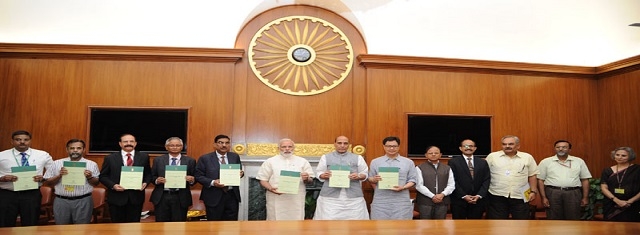News
Prime Minister Releases National Disaster Management Plan
Disaster Resilient

Releasing NDMP (Source: PIB/GR/TYP/BIN/USPA/WN/IAIJ)
USPA NEWS -
The Prime Minister, Mr. Narendra Modi releasing the National Disaster Management Plan (NDMP), ““ 1st ever national plan prepared in the country, in New Delhi on June 01, 2016.
The Plan Aims To Make India Disaster Resilient And Reduce Loss Of Lives
The Plan Aims To Make India Disaster Resilient And Reduce Loss Of Lives
Prime Minister Mr. Narendra Modi released the National Disaster Management Plan (NDMP) on June 1. This is the first ever national plan prepared in the country.
It aims to make India disaster resilient and significantly reduce the loss of lives and assets. The plan is based on the four priority themes of the “Sendai Framework,“ namely: understanding disaster risk, improving disaster risk governance, investing in disaster risk reduction (through structural and non-structural measures) and disaster preparedness, early warning and building back better in the aftermath of a disaster.
It aims to make India disaster resilient and significantly reduce the loss of lives and assets. The plan is based on the four priority themes of the “Sendai Framework,“ namely: understanding disaster risk, improving disaster risk governance, investing in disaster risk reduction (through structural and non-structural measures) and disaster preparedness, early warning and building back better in the aftermath of a disaster.
Picture Description: The Prime Minister, Mr. Narendra Modi releasing the National Disaster Management Plan (NDMP), ““ 1st ever national plan prepared in the country, in New Delhi on June 01, 2016. The Union Home Minister, Mr. Rajnath Singh, the Minister of State for Home Affairs, Mr. Kiren Rijiju and the senior officers of the Prime Minister´s Office, Ministry of Home Affairs and National Disaster Management Authority are also seen.
Doruvu Paul Jagan Babu New Delhi India Prime Minister Narendra Modi National Disaster Management Plan Sendai Framework
Liability for this article lies with the author, who also holds the copyright. Editorial content from USPA may be quoted on other websites as long as the quote comprises no more than 5% of the entire text, is marked as such and the source is named (via hyperlink).





